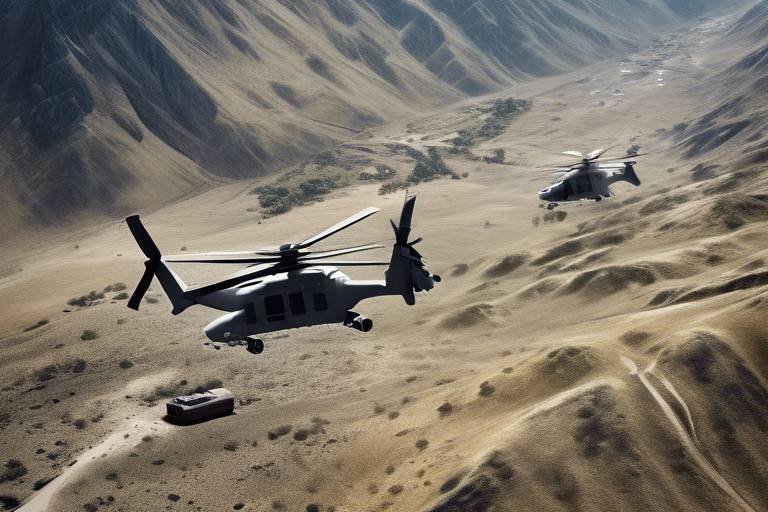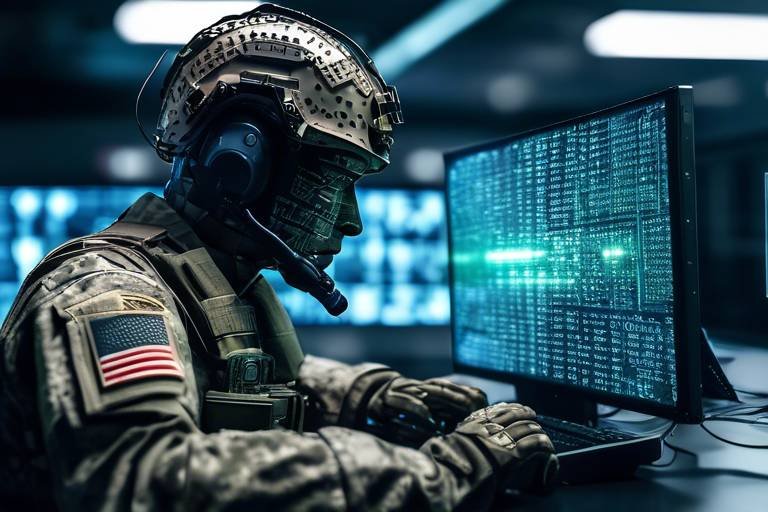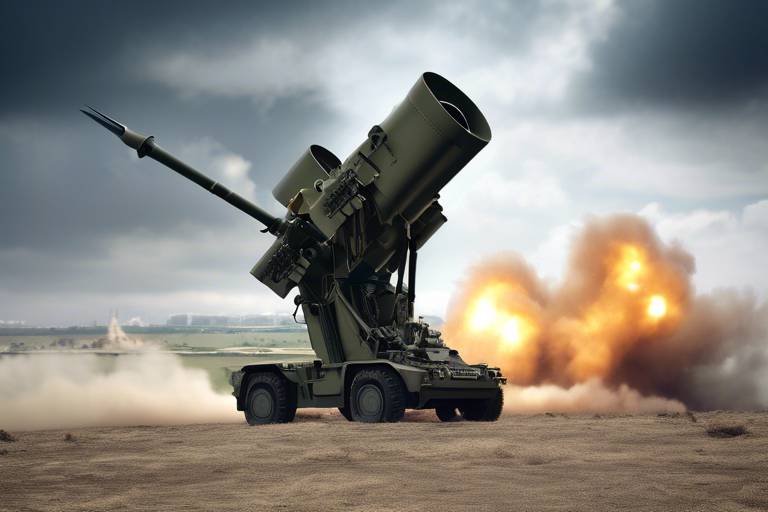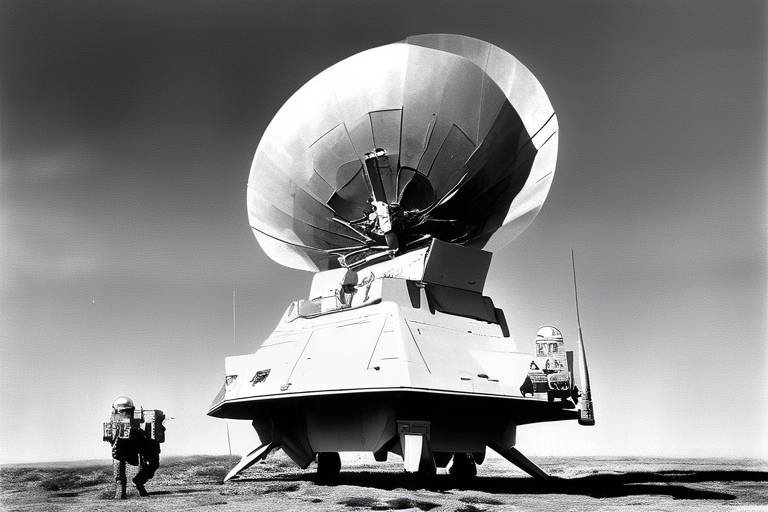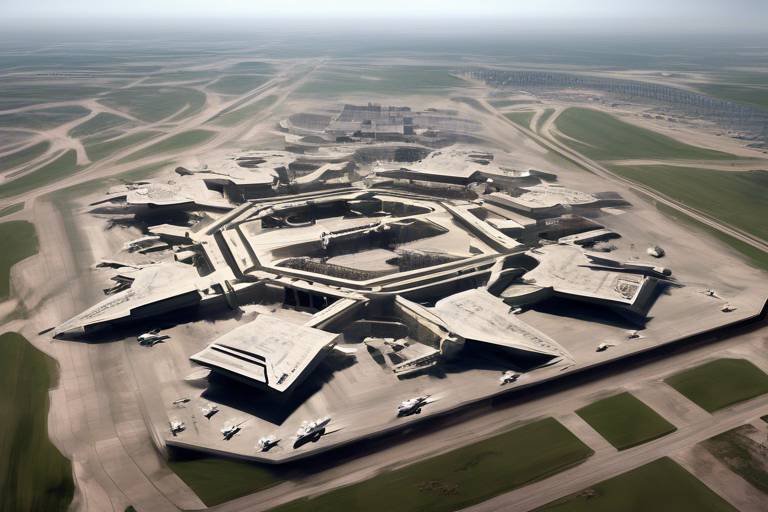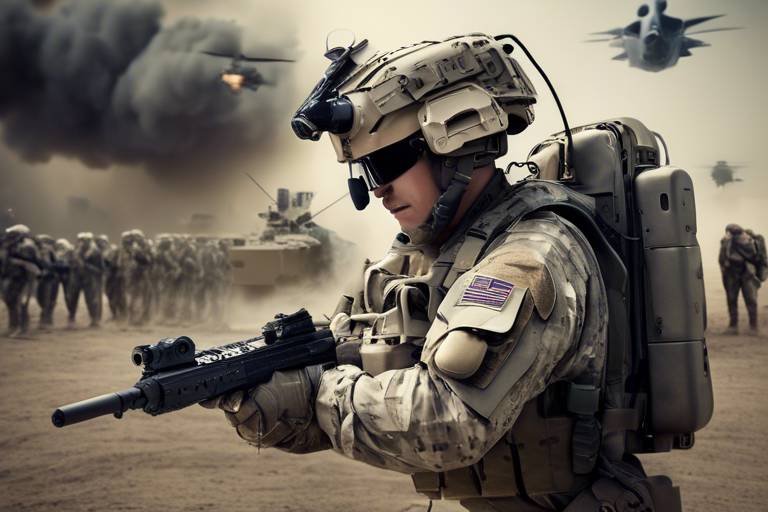AI-Powered Reconnaissance in Mountainous Terrain
The world is evolving at an unprecedented pace, and with it, the methods we use for reconnaissance are transforming dramatically. In the context of mountainous terrain, where traditional reconnaissance methods often struggle, the integration of artificial intelligence (AI) is proving to be a game-changer. Imagine navigating through rugged landscapes, where every twist and turn can hide potential threats or opportunities. AI not only enhances our ability to gather and analyze data but also revolutionizes how we approach decision-making in these challenging environments.
As we delve deeper into this topic, it’s essential to recognize the multifaceted role that AI plays in reconnaissance operations. With its capability to process vast amounts of data quickly and efficiently, AI empowers military and civilian operatives alike to make informed decisions in real-time. This is particularly crucial in mountainous regions, where the terrain can change rapidly due to weather conditions or other factors. By leveraging AI technologies, we can enhance our situational awareness and operational effectiveness, ensuring that we are always one step ahead.
Moreover, the implications of AI-powered reconnaissance extend beyond military applications. In civilian contexts, such as disaster response or environmental monitoring, the ability to accurately assess mountainous terrains can lead to better resource allocation and more effective interventions. For instance, during natural disasters like landslides or avalanches, AI can help identify safe routes for rescue teams, thereby saving lives and minimizing risks.
In summary, the integration of AI into reconnaissance operations in mountainous terrains is not just an enhancement; it’s a necessity. As we continue to explore the innovative applications of this technology, we will uncover new ways to navigate the complexities of these challenging environments. The future is bright, and with AI leading the way, we are set to redefine reconnaissance as we know it.
- How does AI improve reconnaissance in mountainous terrains?
AI enhances reconnaissance by providing real-time data analysis, predictive analytics, and improved decision-making capabilities, allowing operatives to navigate challenging landscapes more effectively.
- What are the main challenges of reconnaissance in mountainous areas?
Challenges include variable weather conditions, difficult navigation, and limited visibility, which can all hinder effective data collection and analysis.
- Can AI be used in civilian applications for mountainous terrain?
Absolutely! AI can assist in disaster response, environmental monitoring, and resource management in mountainous regions, improving safety and operational efficiency.
- What technologies are integrated with AI for reconnaissance?
Technologies such as drones, satellite imagery, and machine learning algorithms are commonly integrated with AI to enhance reconnaissance capabilities.

Understanding AI in Reconnaissance
Artificial intelligence (AI) has revolutionized the way we approach reconnaissance, especially in challenging environments like mountainous terrains. In these rugged landscapes, where traditional methods often struggle, AI stands out as a beacon of innovation. It enables faster data processing, improved decision-making, and enhanced situational awareness, transforming how military and civilian operations are conducted.
Imagine navigating through a dense forest on a steep mountain slope. The visibility is poor, and the terrain is unpredictable. In such scenarios, traditional reconnaissance might rely heavily on human intuition and experience, which can be limited. However, with AI, we can harness the power of algorithms to analyze vast amounts of data quickly. This capability allows for a more comprehensive understanding of the environment, leading to better strategic planning and execution.
One of the key advantages of AI in reconnaissance is its ability to process information from multiple sources simultaneously. For instance, AI can integrate data from satellite imagery, drone surveillance, and ground sensors to create a cohesive picture of the terrain. This integration not only enhances situational awareness but also enables teams to anticipate potential challenges before they arise. The result? Enhanced operational efficiency and reduced risk during missions.
Moreover, AI algorithms can identify patterns and anomalies in data that might go unnoticed by human operators. For example, they can detect subtle changes in vegetation or terrain that could indicate enemy movement or environmental hazards. This predictive capability is crucial in mountainous regions, where conditions can change rapidly and unpredictably.
To illustrate the impact of AI on reconnaissance, consider a scenario where a military unit is tasked with gathering intelligence in a mountainous area. Using AI-powered systems, the unit can:
- Quickly analyze terrain data to identify optimal routes and potential ambush sites.
- Utilize predictive analytics to forecast enemy movements based on historical data.
- Receive real-time updates from drones and sensors, allowing for immediate adjustments to their strategy.
In summary, understanding AI in reconnaissance is about recognizing its transformative potential in overcoming the unique challenges posed by mountainous terrains. By leveraging advanced technologies, we can enhance our ability to gather and analyze critical information, ultimately leading to safer and more effective operations.

Challenges of Mountainous Terrain
Reconnaissance missions in mountainous terrain are often fraught with a myriad of challenges that can significantly impede operational success. Imagine trying to navigate through a maze of jagged cliffs, dense forests, and unpredictable weather patterns. This is the reality for reconnaissance teams operating in such environments. The unique topographical features of mountains can create variable weather conditions that change rapidly, making it difficult to maintain consistent visibility. Fog, rain, and snow can roll in unexpectedly, reducing visibility to mere feet and complicating the task of gathering accurate intelligence.
Moreover, the difficult navigation in these rugged landscapes poses another significant hurdle. Traditional reconnaissance methods, which often rely on ground troops or vehicles, can be rendered ineffective in steep or rocky areas. The terrain's natural obstacles—such as boulders, ravines, and dense underbrush—can slow down movement and increase the risk of accidents. This not only affects the speed of data collection but also places personnel in harm's way. Thus, the need for advanced technological solutions becomes paramount.
In addition to navigation issues, reconnaissance teams must also contend with limited visibility. Whether due to weather or the natural features of the landscape, the inability to see far ahead can severely limit situational awareness. This is where artificial intelligence can play a crucial role by providing enhanced data analysis capabilities. By integrating AI with aerial surveillance and remote sensing technologies, teams can overcome some of these visibility challenges. AI can process and analyze data from various sources, creating a clearer picture of the operational environment, even when visibility is compromised.
Furthermore, the unpredictability of mountainous environments can lead to communication challenges. The rugged terrain can obstruct radio signals, making it difficult for teams to maintain contact with command centers. This lack of communication can lead to delays in decision-making and hinder the ability to adapt to rapidly changing situations. To mitigate this, the integration of satellite communications and advanced networking technologies is essential to ensure that teams remain connected, regardless of their location.
In summary, the challenges posed by mountainous terrain are multifaceted and require innovative solutions to ensure successful reconnaissance operations. By leveraging advanced technologies, including AI and integrated sensor systems, teams can navigate these obstacles more effectively. The future of reconnaissance in such challenging environments lies in the ability to adapt and utilize the latest advancements in technology to overcome the inherent difficulties presented by the mountains.
- What are the main challenges of reconnaissance in mountainous terrain?
The main challenges include variable weather conditions, difficult navigation, limited visibility, and communication issues. - How does AI help in overcoming these challenges?
AI enhances data analysis, improves situational awareness, and facilitates real-time decision-making, which is crucial in unpredictable environments. - What technologies are commonly used in mountainous reconnaissance?
Technologies such as drones, satellite imagery, and remote sensing are commonly used to gather data in mountainous regions. - Why is communication a challenge in mountainous terrain?
The rugged landscape can obstruct radio signals, making it difficult for reconnaissance teams to maintain contact with command centers.

Terrain Analysis Techniques
When it comes to reconnaissance in mountainous terrain, the key to success lies in effective terrain analysis techniques. These techniques leverage the power of artificial intelligence to transform raw data into actionable insights. By analyzing various elements such as topography, vegetation, and obstacles, AI algorithms can significantly enhance strategic planning and operational execution. Imagine trying to navigate a dense forest without a map; it’s not just challenging, it can be downright dangerous. Similarly, in reconnaissance, understanding the lay of the land is crucial for making informed decisions.
One of the most exciting developments in this field is the use of machine learning algorithms for terrain mapping. These algorithms sift through vast datasets—think satellite images, aerial photographs, and even ground-level scans—to create highly accurate terrain maps. This is akin to piecing together a jigsaw puzzle where each piece represents a critical feature of the landscape. The result? A comprehensive view that helps reconnaissance teams identify vital elements such as potential hiding spots for adversaries or natural barriers that could affect troop movements.
Moreover, the integration of various sensors, such as drones and satellite imagery, has revolutionized how reconnaissance missions are conducted in mountainous environments. These sensors collect real-time data that, when processed through AI systems, provide an up-to-the-minute picture of the operational landscape. This capability is essential, especially in unpredictable mountainous terrains where conditions can change rapidly. For instance, a sudden landslide or a shift in weather can drastically alter the situation on the ground, making real-time data collection not just beneficial, but vital.
To further illustrate the impact of these terrain analysis techniques, consider the following table that outlines some of the key AI-driven methods and their benefits:
| Technique | Description | Benefits |
|---|---|---|
| Machine Learning Mapping | Utilizes algorithms to analyze terrain data. | Creates accurate maps for strategic planning. |
| Sensor Integration | Combines data from drones and satellites. | Provides real-time situational awareness. |
| Remote Sensing | Collects data from a distance using various technologies. | Minimizes risk while maximizing information gathering. |
In conclusion, the use of AI in terrain analysis techniques is not just a trend; it's a necessity in modern reconnaissance operations, especially in the challenging environments presented by mountainous regions. As technology continues to advance, we can expect even more sophisticated methods to emerge, making reconnaissance safer and more efficient. So, the next time you think about reconnaissance in rugged landscapes, remember that behind the scenes, a complex web of AI-driven analysis is working tirelessly to ensure mission success.
- What are the main benefits of using AI in terrain analysis? AI enhances accuracy, speeds up data processing, and improves decision-making capabilities, especially in complex terrains.
- How do machine learning algorithms create terrain maps? They analyze large datasets, identifying patterns and features that inform strategic planning.
- What types of sensors are commonly used in reconnaissance? Drones, satellites, and ground sensors are among the most commonly used technologies for data collection.
- Why is real-time data important in mountainous reconnaissance? Conditions in mountainous areas can change rapidly, making up-to-date information crucial for effective decision-making.

Machine Learning for Terrain Mapping
Machine learning has revolutionized the way we approach terrain mapping, especially in the rugged and unpredictable landscapes of mountainous regions. Traditional mapping techniques often struggle to keep pace with the complexities presented by such environments, where elevation changes, vegetation density, and weather conditions can vary dramatically over short distances. By leveraging machine learning algorithms, we can analyze vast datasets derived from satellite imagery, aerial surveys, and ground-based sensors to create highly accurate and detailed terrain maps.
One of the key advantages of using machine learning in terrain mapping is its ability to process and interpret large volumes of data quickly. For instance, algorithms can identify patterns and features within the terrain that might be overlooked by human analysts. This capability is particularly beneficial when it comes to recognizing critical elements such as:
- Natural obstacles like cliffs and ravines
- Vegetation types that may impact visibility
- Potential paths for movement, both for personnel and vehicles
Furthermore, machine learning models can continuously improve their accuracy over time. As they are fed more data, they learn from past mistakes and refine their predictions, leading to better mapping outcomes. This iterative process is akin to training a muscle; the more you work at it, the stronger and more efficient it becomes. For military operations, this means that reconnaissance teams can rely on terrain maps that not only reflect current conditions but also anticipate changes due to factors like weather or human activity.
To illustrate the impact of machine learning on terrain mapping, consider the following table that summarizes the differences between traditional mapping methods and machine learning-enhanced approaches:
| Aspect | Traditional Mapping | Machine Learning Mapping |
|---|---|---|
| Data Processing Speed | Slow, manual analysis | Fast, automated processing |
| Accuracy | Subject to human error | High, data-driven accuracy |
| Adaptability | Static maps | Dynamic, continuously updated maps |
| Scalability | Limited by resources | Scalable with additional data |
In conclusion, the integration of machine learning into terrain mapping is not just a technological advancement; it represents a paradigm shift in how we understand and navigate mountainous terrains. By providing detailed insights and fostering a proactive approach to reconnaissance, machine learning empowers military and civilian operatives alike to make informed decisions that enhance safety and operational effectiveness. As we look to the future, the potential applications of these technologies will undoubtedly expand, paving the way for even more sophisticated reconnaissance strategies.
- What is machine learning in the context of terrain mapping? Machine learning refers to algorithms that analyze large datasets to identify patterns and features in terrain, enabling the creation of accurate maps.
- How does machine learning improve accuracy in terrain mapping? By processing vast amounts of data and learning from previous analyses, machine learning models can refine their predictions and reduce human error.
- What types of data are used for machine learning in terrain mapping? Data can include satellite imagery, aerial surveys, and information from ground-based sensors.
- Can machine learning models adapt to changing environments? Yes, these models can continuously learn and update their predictions based on new data, making them highly adaptable.

Sensor Integration
In the realm of reconnaissance, particularly in the challenging landscapes of mountainous terrain, the integration of various sensors is nothing short of revolutionary. Imagine a world where drones equipped with advanced imaging technology can soar over rugged peaks, capturing high-resolution images and gathering critical data in real-time. This is not just a futuristic dream; it’s the reality brought forth by the marriage of artificial intelligence and sensor technology. By leveraging a combination of drones, satellite imagery, and ground sensors, military and civilian operations can achieve unprecedented levels of situational awareness.
The beauty of sensor integration lies in its ability to synthesize information from multiple sources, providing a comprehensive view of the operational environment. For instance, drones can be deployed to survey inaccessible areas, while ground sensors can monitor movement and environmental changes. The data collected by these devices is then processed using AI algorithms, transforming raw information into actionable insights. This synergy not only enhances reconnaissance capabilities but also significantly reduces the risks associated with human operatives navigating treacherous terrains.
Furthermore, the integration of these sensors allows for the creation of a real-time data network, where information flows seamlessly from one device to another. This interconnectedness is crucial in mountainous regions where conditions can change rapidly. For example, if a drone detects an unexpected weather shift or identifies potential threats, it can instantly relay that information to command centers, enabling swift tactical adjustments. This level of responsiveness is vital for maintaining operational effectiveness in unpredictable environments.
To illustrate the impact of sensor integration, consider the following table that outlines various types of sensors and their contributions to reconnaissance:
| Sensor Type | Function | Benefits |
|---|---|---|
| Drones | Aerial surveillance and imaging | Access to hard-to-reach areas; real-time data collection |
| Satellite Imagery | Wide-area monitoring | Comprehensive views of large regions; historical data analysis |
| Ground Sensors | Movement and environmental monitoring | Real-time alerts; detailed local data |
In essence, the integration of these sensors not only enhances the capabilities of reconnaissance missions but also paves the way for more informed decision-making processes. As technology continues to evolve, the potential applications of sensor integration in reconnaissance are boundless, promising a future where operations in mountainous terrains are safer, more efficient, and incredibly effective.
- What is sensor integration in reconnaissance?
Sensor integration refers to the combination of various sensing technologies, such as drones and ground sensors, to gather and analyze data in real-time, enhancing situational awareness and operational efficiency. - How do drones contribute to reconnaissance in mountainous terrain?
Drones provide aerial surveillance capabilities, allowing for the collection of high-resolution images and data from areas that are difficult to access, significantly improving reconnaissance efforts. - What role does AI play in sensor integration?
AI processes the data collected from various sensors, transforming it into actionable insights and facilitating rapid decision-making in reconnaissance operations.

Data Collection Methods
In the realm of reconnaissance, particularly in the challenging environments of mountainous terrain, the methods of data collection are nothing short of revolutionary. These methods are designed to overcome the inherent obstacles presented by rugged landscapes, such as steep inclines, dense vegetation, and unpredictable weather. Traditional reconnaissance often relied heavily on human observation and ground patrols, which can be both time-consuming and dangerous. However, with the integration of artificial intelligence and advanced technologies, the landscape of data collection has dramatically transformed.
One of the most significant advancements in this field is the use of remote sensing technologies. These systems utilize satellites and aerial vehicles to gather information from a distance, thereby minimizing the risks to personnel. For instance, drones equipped with high-resolution cameras and sensors can fly over difficult terrains, capturing detailed images and data that would be nearly impossible to obtain otherwise. This method not only enhances safety but also allows for a broader coverage area, making it easier to identify potential threats or gather intelligence.
Moreover, the integration of AI algorithms with these data collection methods enables the processing of vast amounts of information in real-time. Imagine having a drone that not only captures images but also analyzes them on-the-fly, identifying key features such as enemy positions, natural obstacles, and even weather patterns. This capability is particularly crucial in mountainous regions, where conditions can change rapidly and where timely information can mean the difference between success and failure in a mission.
Another innovative approach is the use of aerial surveillance. This method involves the deployment of aircraft equipped with sophisticated sensors and imaging technology. These aircraft can cover large areas quickly and provide reconnaissance teams with up-to-date information about the terrain, enemy movements, and other critical factors. The data collected can be processed and analyzed by AI systems to generate actionable insights, ensuring that reconnaissance operations are both effective and efficient.
In addition to these methods, ground sensors can also play a vital role in data collection. These sensors can be strategically placed in various locations to monitor activity and gather environmental data. For example, seismic sensors can detect movement in the ground, alerting teams to potential enemy movements. When combined with the analytical power of AI, the information gathered from these sensors can provide a comprehensive picture of the operational environment.
To summarize, the modern data collection methods employed in reconnaissance operations within mountainous terrain are multifaceted and highly advanced. They include:
- Remote Sensing Technologies: Utilizing satellites and drones for aerial data collection.
- Aerial Surveillance: Deploying aircraft with advanced imaging systems for real-time intelligence.
- Ground Sensors: Using strategically placed sensors to monitor activity and gather environmental data.
These methods not only enhance situational awareness but also significantly reduce the risks associated with traditional reconnaissance. As technology continues to evolve, we can expect even more sophisticated data collection methods to emerge, further improving the effectiveness of reconnaissance missions in even the most challenging environments.
- What is the role of AI in data collection for reconnaissance? AI enhances data collection by processing large volumes of information quickly, identifying patterns, and providing actionable insights in real-time.
- How do drones improve reconnaissance in mountainous terrain? Drones can access hard-to-reach areas, collect high-resolution images, and gather data without putting personnel at risk.
- What are ground sensors, and how do they contribute to reconnaissance? Ground sensors monitor environmental changes and detect movements, providing critical information that can be analyzed alongside aerial data.

AI Algorithms for Decision Making
In the realm of reconnaissance, especially in the challenging mountainous terrains, AI algorithms serve as the backbone for effective decision-making. Imagine being in a situation where every second counts, and the terrain is as unpredictable as a mountain storm. This is where AI steps in, processing vast amounts of data almost instantaneously to provide actionable insights. By leveraging real-time data, these algorithms can quickly assess the changing landscape, identify potential threats, and recommend tactical responses. This capability is not just a luxury; it's a necessity for success in complex environments.
One of the standout features of AI algorithms is their ability to utilize predictive analytics. Think of it as having a crystal ball that not only shows you the present but also forecasts future scenarios. By analyzing patterns from historical data, AI can predict enemy movements and environmental shifts. For instance, if an enemy group typically moves through a particular pass during adverse weather, the algorithm can highlight this probability, allowing reconnaissance teams to prepare accordingly. This proactive approach significantly enhances mission effectiveness, enabling teams to stay one step ahead of potential threats.
Moreover, the integration of real-time data processing capabilities transforms how reconnaissance teams operate. In mountainous regions, where conditions can change rapidly, having access to the latest information is crucial. AI algorithms can analyze data from multiple sources—drones, satellites, and ground sensors—synthesizing this information into a coherent picture. This allows operatives to make informed decisions based on the most current data available. For example, if a sudden storm rolls in, AI can quickly assess its impact on visibility and recommend alternative routes or strategies, ensuring the safety and efficiency of the operation.
To illustrate the impact of AI algorithms in decision-making, consider the following table that outlines the key benefits:
| Benefit | Description |
|---|---|
| Speed | AI algorithms process data rapidly, enabling quick decision-making. |
| Accuracy | Advanced analytics lead to more precise predictions and assessments. |
| Adaptability | Real-time processing allows teams to adjust strategies on the fly. |
| Proactivity | Predictive analytics help anticipate threats before they materialize. |
In conclusion, AI algorithms are revolutionizing the way decisions are made in reconnaissance operations, particularly in mountainous terrains where traditional methods may falter. By harnessing the power of real-time data and predictive analytics, these algorithms not only enhance operational efficiency but also ensure that teams are better prepared to face the unpredictable challenges that lie ahead. As technology continues to evolve, we can only anticipate even greater advancements in AI's role in reconnaissance, making our operations safer and more effective.
- What are AI algorithms in reconnaissance? AI algorithms in reconnaissance are advanced computational methods that analyze data to assist in decision-making processes during missions.
- How do predictive analytics enhance reconnaissance? Predictive analytics enhance reconnaissance by forecasting potential threats and environmental changes, allowing teams to take proactive measures.
- Why is real-time data processing important? Real-time data processing is crucial because it enables reconnaissance teams to adapt quickly to changing conditions, ensuring decisions are based on the most current information.
- What role do AI algorithms play in military operations? AI algorithms improve operational efficiency, enhance situational awareness, and help in strategic planning by providing timely insights and recommendations.

Predictive Analytics
Predictive analytics is revolutionizing the way reconnaissance operations are conducted, particularly in the unpredictable and often treacherous landscapes of mountainous terrain. By leveraging advanced algorithms and machine learning, this technology can analyze historical data, identify patterns, and forecast potential future events. Imagine having the ability to anticipate enemy movements or sudden weather changes before they happen—this is where predictive analytics shines.
At its core, predictive analytics utilizes a combination of statistical techniques and machine learning algorithms to sift through massive datasets. This process allows reconnaissance teams to gain insights that were previously unattainable. For instance, by analyzing past reconnaissance missions, AI can identify which routes were most frequently used by adversaries, thereby suggesting alternative paths that could be safer for operatives.
In the context of mountainous terrains, the benefits are manifold:
- Threat Anticipation: By analyzing data from various sources, such as satellite imagery and drone surveillance, predictive analytics can forecast potential threats, allowing teams to prepare and respond proactively.
- Resource Allocation: AI can optimize the deployment of resources by predicting the best times and locations for reconnaissance activities, ensuring that assets are used efficiently.
- Environmental Adaptation: Changes in weather conditions can significantly impact reconnaissance operations. Predictive analytics can help teams adapt to these changes by providing timely updates and recommendations.
Moreover, the integration of predictive analytics into reconnaissance strategies is not just about reacting to potential threats; it's about creating a comprehensive operational framework. For example, if data indicates a high probability of enemy activity in a specific area, teams can adjust their strategies accordingly. This adaptability can mean the difference between success and failure in high-stakes missions.
Looking ahead, the role of predictive analytics in reconnaissance is expected to grow even more significant. As AI technologies continue to evolve, the accuracy of predictions will improve, leading to more effective decision-making processes. This means that operatives can enter mountainous terrains with a clearer understanding of what to expect, significantly enhancing their chances of success.
In summary, predictive analytics is not just a tool; it is a game-changer for reconnaissance operations in mountainous environments. By providing actionable insights and forecasts, it empowers teams to navigate challenges with confidence, ensuring that they are always one step ahead of potential threats.
- What is predictive analytics? Predictive analytics involves using statistical algorithms and machine learning techniques to identify the likelihood of future outcomes based on historical data.
- How does predictive analytics improve reconnaissance? It enhances reconnaissance by allowing teams to anticipate threats, optimize resource allocation, and adapt to environmental changes through data-driven insights.
- Can predictive analytics be used in civilian applications? Yes, predictive analytics is widely used in various civilian sectors, including disaster management, urban planning, and environmental monitoring.

Real-time Data Processing
In the fast-paced world of reconnaissance, especially in the rugged and unpredictable mountainous terrain, is not just a luxury; it's a necessity. Imagine being able to analyze vast amounts of data as it comes in, making split-second decisions that could mean the difference between mission success and failure. This capability is powered by advanced artificial intelligence algorithms that can sift through data streams from various sources, such as drones, satellites, and ground sensors, in the blink of an eye.
The essence of real-time data processing lies in its ability to adapt to changing environments. For instance, consider a reconnaissance team operating in a remote mountain range. As they gather information about enemy positions and terrain features, the conditions can shift dramatically due to weather changes or unexpected enemy movements. With AI-driven real-time processing, the team can receive immediate updates, allowing them to adjust their strategies promptly. This is akin to having a GPS that not only shows your route but also reroutes you based on real-time traffic conditions.
Moreover, real-time data processing enhances situational awareness by integrating various data types into a cohesive picture. This includes not just visual data from cameras but also thermal imaging, radar signals, and even environmental sensors that monitor factors like temperature and humidity. The integration of these diverse data sources allows reconnaissance teams to understand their surroundings better and make informed decisions. For example, if a sudden storm is detected, the AI can alert the team to potential hazards, enabling them to take precautions or alter their mission parameters.
Here's a quick overview of how real-time data processing works in reconnaissance:
| Component | Function |
|---|---|
| Drones | Provide aerial surveillance and real-time video feeds. |
| Satellites | Offer broad coverage and high-resolution imagery. |
| Ground Sensors | Detect movement and environmental changes on the ground. |
| AI Algorithms | Analyze data rapidly to identify patterns and threats. |
In conclusion, the integration of real-time data processing in reconnaissance missions is revolutionizing how operations are conducted in mountainous terrains. The ability to process and act on data as it arrives not only increases the efficiency of military operations but also enhances safety for personnel on the ground. As technology continues to advance, we can expect even more sophisticated systems that will further refine this capability, making reconnaissance smarter, faster, and more responsive to the challenges of the environment.
- What is real-time data processing? Real-time data processing refers to the immediate analysis and interpretation of data as it is collected, enabling quick decision-making in dynamic environments.
- How does AI improve reconnaissance? AI enhances reconnaissance by enabling faster data processing, predictive analytics, and improved situational awareness, particularly in challenging terrains like mountains.
- What types of data are used in reconnaissance? Reconnaissance utilizes various data types, including visual imagery, thermal data, radar signals, and environmental sensor readings.
- Why is real-time data processing important in mountainous terrain? It is crucial because mountainous areas are unpredictable, and conditions can change rapidly, requiring immediate adjustments to strategies and operations.

The Future of AI in Reconnaissance
The future of AI in reconnaissance is not just bright; it’s downright dazzling! As technology continues to evolve at breakneck speed, the integration of artificial intelligence into reconnaissance operations is set to revolutionize how we approach data collection and analysis in challenging environments, particularly in mountainous terrain. Imagine a world where reconnaissance teams can seamlessly access real-time data, predict enemy movements, and adapt their strategies on the fly, all thanks to the power of AI. It’s like having a crystal ball that not only tells you what’s coming but also guides you on how to react.
One of the most exciting prospects for the future of AI in reconnaissance is the advancement of autonomous systems. Drones and unmanned ground vehicles (UGVs) are becoming increasingly sophisticated, equipped with AI algorithms that allow them to navigate complex terrains without human intervention. These autonomous systems can conduct surveillance missions in treacherous mountainous areas, gathering critical information while keeping human operatives out of harm's way. The ability to deploy these systems during adverse weather conditions or in high-risk environments will enhance operational safety and efficiency.
Moreover, machine learning will continue to play a pivotal role in refining reconnaissance strategies. As AI systems learn from vast amounts of data, they will become better at identifying patterns and anomalies, improving their predictive capabilities. For instance, by analyzing historical data on enemy movements and environmental factors, AI can provide actionable insights that help military and civilian operatives stay one step ahead. This predictive power is akin to having an experienced guide who knows the terrain intimately, allowing teams to navigate potential threats with confidence.
In addition, the future will see enhanced collaboration between AI systems and human intelligence. While AI can process data at lightning speed, the human element remains crucial for interpreting that data and making strategic decisions. The synergy between AI and human operatives will create a more robust reconnaissance framework, where technology supports human intuition and experience. This partnership can significantly reduce response times and improve mission outcomes, especially in unpredictable mountainous environments.
As we look ahead, the implications of AI in reconnaissance extend beyond military applications. In civilian sectors, such as disaster response and environmental monitoring, AI-enhanced reconnaissance can aid in assessing damage during natural disasters or monitoring wildlife in rugged landscapes. The versatility of AI systems will enable them to adapt to various challenges, making them invaluable tools in both military and civilian contexts.
- What role does AI play in reconnaissance operations?
AI enhances data processing, decision-making, and situational awareness, especially in complex terrains like mountains. - How do autonomous systems improve reconnaissance?
Autonomous drones and vehicles can navigate difficult terrains and gather data without risking human lives. - Can AI predict enemy movements?
Yes, AI can analyze historical data to forecast potential threats, improving mission effectiveness. - What are the civilian applications of AI in reconnaissance?
AI can aid in disaster response, environmental monitoring, and wildlife conservation efforts.
Frequently Asked Questions
- What is AI-powered reconnaissance?
AI-powered reconnaissance refers to the use of artificial intelligence technologies to enhance the collection, analysis, and interpretation of data during reconnaissance missions. This approach allows for quicker data processing and improved decision-making, especially in challenging environments like mountainous terrains.
- What challenges do mountainous terrains pose for reconnaissance?
Mountainous terrains present unique challenges such as unpredictable weather conditions, difficult navigation, and limited visibility. These factors can significantly hinder effective data collection and analysis, making advanced technological solutions essential for successful reconnaissance operations.
- How does machine learning contribute to terrain mapping?
Machine learning algorithms analyze extensive datasets to produce accurate terrain maps. By identifying critical features such as elevation changes and vegetation types, these algorithms help inform reconnaissance strategies, ultimately improving mission outcomes in rugged landscapes.
- What types of sensors are integrated into AI reconnaissance systems?
AI reconnaissance systems often integrate various sensors, including drones, satellite imagery, and ground-based sensors. This integration allows for real-time data collection and analysis, which is crucial for effective operations in complex mountainous environments.
- How does AI enhance decision-making in reconnaissance?
AI enhances decision-making by processing real-time data to predict potential threats and recommend tactical responses. This capability allows reconnaissance teams to make informed decisions quickly, significantly improving operational efficiency in mountainous terrains.
- What role does predictive analytics play in reconnaissance?
Predictive analytics powered by AI can forecast enemy movements and environmental changes. This foresight enables reconnaissance teams to take proactive measures, thereby enhancing overall mission effectiveness in unpredictable mountainous environments.
- What is the future of AI in reconnaissance operations?
The future of AI in reconnaissance looks bright, with ongoing advancements in technology expected to further enhance capabilities in mountainous terrain. These improvements will likely lead to safer and more efficient operations for both military and civilian applications.

